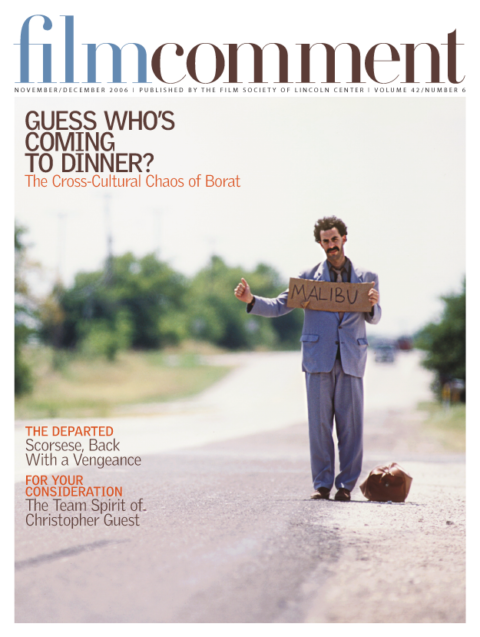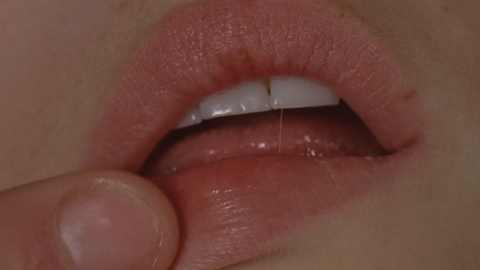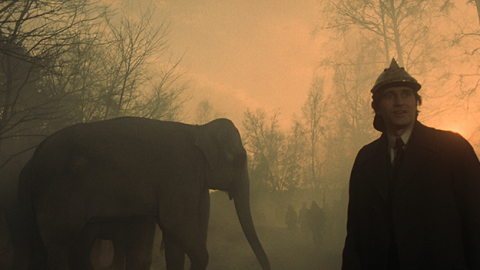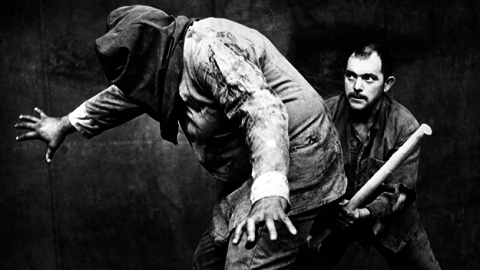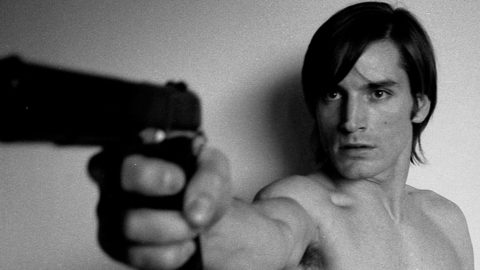
Goto, Island of Love
The strange case of Walerian Borowczyk, Polish-born animator, artist, and filmmaker, remains open even after his death at the age of 82 on February 3 of this year. The obituaries in France praised him for his artistic vision; those in Britain and the U.S. recounted the usual caveat that blighted his reputation amongst earnest cinephiles—that he became a pornographer. The charge comes from Borowczyk’s embrace of a relaxation in French film censorship in the Seventies and his unashamed commitment to celebrating tales relating in different time periods the triumph of sexual obsession over Christian convention and morality; and unquestionably Borowczyk’s most notorious and provocative film, The Beast (La Bête , 75). In the latter, an American heiress has a recurring dream of ravishment by a hairy, bear-like monster with a huge penis. The fantasy eventually overwhelms the real world of her arranged marriage into a decadent French aristocracy. While Goto, made in austere black-and-white (with some subliminal-and sublime-flashes of color), is relatively chaste, its successors are dominated by a camera transfixed by female flesh, especially when glimpsed through sheer cloth or caressed by running water.
However, these titles (in regular circulation because the rights reside with Argos Films, the one French production house that has always supported him) give only a partial view of Borowczyk’s achievements. He was born in Poland in 1923, studied painting at the Academy of Fine Arts in Krakow, and entered the film business by designing posters. In collaboration with another (also recently deceased) graphic artist, Jan Lenica, he turned to animation, which, through exposure at festivals and the rise of art-house distribution, won prizes, excited audiences, and garnered critical admiration. In House (Dom, 58), a sophisticated application of stop-motion and sound effects enables objects to take on lives of their own. A scurrying wig devours everything on a kitchen table. A mannequin head breaks apart when amorously stroked by a woman. The latter was played by Ligia Branice, the director’s wife and muse, the female body, and it’s one that will remain unresolved in a culture that prefers restraint, discretion, and a constant vigilance over any assault on taboo subjects or dedication to the erotic. The director’s comment: “Anything that’s beautiful is definitely not pornography. The very term belongs to legislation, not to art. Erotic films show the fascination that physical love exerts on us. Art has the right to engage itself with the most secret realms of our thoughts—that’s its privilege.”
Gradually his work is sneaking out from behind the covers once again on DVD, with an emphasis on the early live-action features: Goto, Island of Love (Goto, l’ile d’amour, 68), a magnificent adult fairy tale about an isolated dictatorship in which a proud ruler is brought down by jealousy stoked by an ambitious worker; Immoral Tales (Contes immoraux, 74), four scandalous short whose own special fragility would shine in his first live-action works.

Angel’s Games
Borowczyk’s strange and provocative experiments in animation came to a peak with his move to France in the late Fifties. A trademark element (highly influential upon Terry Gilliam, for example) was the use of old documents and prints as source material, which Borowczyk cut and manipulated, transforming their shapes and purposes. His short-form masterpiece, Angel’s Games (Les Jeux des anges, 64), is an oblique representation of the rituals of the concentration camp. Gouache paintings depict box-like enclosures with mysterious sectioned organ pipes in which human body parts are brought together and broken apart. Renaissance (63) begins with an explosion after which the scattered and fragmented contents of a room gradually reassemble themselves, until the last object, a grenade, pulls its own pin, and the blast returns the scene to chaos. It’s as if Borowczyk saw life and death, creation and destruction, as equal in their power to inspire.
Nowhere was this more directly expressed than in his astounding feature-length animation, Théâtre de M. and Mme. Kabal (Mr. and Mrs. Kabal’s Theatre, 67). Little seen today, it’s a unique example of a hand-drawn film aimed at an adult audience. It combines scratchy black ink lines on a white background with a thoroughly abrasive soundtrack. The character of Mr. Kabal is a diminutive dreamer, his wife a monstrous figure prone to violent outbursts, and together they form a grotesque, warring couple who make their home amidst scuttling four-legged creatures and hovering butterflies. The surprise is that it’s Mrs. Kabal who eventually transcends her dreams by creating an impossibly vast munitions factory within their house—but out of the mayhem she causes, an uneasy peace is eventually restored.
It’s essential to remember this disturbing vision when looking at Borowczyk’s live-action films. In the short Rosalie (66), Branice plays a teenage girl accused of murdering her baby, and is filmed as if she is on the witness stand. While she tells her story of misery and exploitation, significant objects appear in the frame, assuming a weight equal to her tears in emotional impact. Throughout Borowczyk’s films, the paraphernalia that surrounds people is as fascinating and potent as the creatures themselves. In a 1976 interview with Carlos Clarens in FILM COMMENT, he remarked: “Through objects you discover human nature. Have you ever seen an object created by nature that had any rapport with man? Rarely. Only that which has been crafted by someone.” Borowczyk’s viewpoint is almost always frontal—you’ll be hard-pressed to discover the conventional shot-reverse shot formula anywhere in his output. What you do find is a pervasive sense of filmwatching as voyeurism—people are constantly shown looking through telescopes or spying through keyholes. The act of looking at things becomes the art of looking at things.

Blanche
So if objects become living matter for Borowczyk, does that mean people become objectified by his camera? Let’s say that it’s an essential leap of faith the spectator has to make to enjoy his cinema and surrender to its peculiar beauty. By his own admission, Borowczyk was far more interested in the visual essence of his films than in telling psychological stories. He was often branded a surrealist, partly, no doubt, for the praise that he received from figures such as Max Ernst and Andre Breton, who applauded Borowczyk’s imagindtion fulgurante (dazzling imagination). But Borowczyk’s attitude was more that of a painter-filmmaker, following a tradition traceable from Josef von Sternberg to Peter Greenaway. Borowczyk was a great admirer of The Draughtsman’s Contract and, like Greenaway, would show off his art-history references, especially in his stunning recreation of medieval tapestry forms in Blanche (71), or Renaissance Italy in the Marguerite episode of Three Immoral Women (Les Heroines du mal, 79). But to my mind he’s closer to Sternberg, not only for their mutual obsession with decor and materials, but for approaching the film image as an artist’s canvas fit for the exploration of the unconscious—not to mention man’s overwhelming adoration (and fear) of woman.
This, bien sûr, is the anxious territory where Borowczyk’s admirers and detractors diverge. The director himself demonstrated a shift in attitude throughout the feature films, and characteristically his generosity increased the more provocative his female characters became. At first, he cast Branice as a put-upon victim in Goto and Blanche, and a similar misery dogged the heroine of Story of Sin (75), made by Borowczyk on a rare return to Poland. An unashamed melodrama drawn from a novel maudit by Stefan Zeromski, the film depicts a young girl’s persistent pursuit of her lover all over Europe, enduring a self-induced abortion and prostitution en route. Borowczyk’s camera, far looser than before, delights in the bric-a-brac of the late 19th century—brass beds, phonographs, corsets, pornographic engravings—as much as the emotional extremity on display.
The success of this film and the two he made for producer Anatole Dauman (Immoral Tales, The Beast) led him to the Hakim Brothers and the bizarre star coupling of Joe Dallesandro and Sylvia Kristel (hot from Emmanuelle) in The Margin (La Marge, 76). Basing his script on a prix Goncourt-winning novel by Andre Pieyre de Mandiargues, the director was obliged to transpose the story from Franco’s Spain to the demimonde of mid-Seventies Paris. But by clothing his characters predominantly in black, moving them around dark streets and sparse hotel rooms, and finally plunging them into a forbidding Metro, Borowczyk creates a hallucinatory underworld for Little Joe’s Orpheus. His scenes with Kristel as the prostitute with whom he becomes obsessed have a surprisingly delicate intimacy. However, when Dallesandro exits the frame, she has little choice but to go back to business at a bar that is distinctively a Boro-world, filled with secret doorways and dusty cabinets containing ripe fruit.

Immoral Tales
But the women who are depicted in Immoral Tales, The Beast, and the highly enjoyable nuns-at-play romp Behind Convent Walls (77) prove more resilient in the face of oppression and exploitation, and frequently discover their pleasures without the need of a masculine presence. In Three Immoral Women, a triptych of revenge stories, the vindictive heroines are triumphantly assertive and blithely disengaged from the men who cross them. In 1980, Borowczyk replaced Liliana Cavani as director on a version of Wedekind’s Lulu, with the central character played by the child-woman Anne Bennent (sister of David Bennent, the stunted boy in The Tin Drum). Adhering to the words of the original play, this seldom-seen film is faithful to Wedekind’s concept of the alluring female as the ultimate embodiment of male obsession. Borowczyk followed this a year later with another adaptation of a classic, Stevenson’s Dr. Jekyll and Mr. Hyde, but delved into its subtext to give greater weight to Jekyll’s wife, Fanny Osbourne, who becomes an eager participant in his experiment to release humanity, body and soul, from all moral restraint.
This foray into the fantastique is Borowczyk’s last great film, though it’s an unashamedly messy one-a passionate, delirious farce that slashes through the false respectability of Victorian society. Dr. Jekyll (the fey Udo Kier) immerses himself in a transforming bath and emerges as another creature altogether: tall, muscular, and seen—in a few subliminal shots—sporting a vicious phallus. Fanny is played by Italian actress Marina Pierro, who starred in most of Borowczyk’s late features and became a muse to supplant Branice. While the latter usually portrayed a precious flower in danger of being trampled, Pierro’s proud Italianate features, confident pose, and well-rounded body signified a perfect femininity for the Polish director. In his last film, Love Rites (Ceremonie d’amour, 88), she plays a prostitute who turns the tables on her vain client and tortures him with birdlike talons attached to her fingers.
How much were these last films the work of a brave auteur, and how much the output of a slave to the flesh markets? Borowczyk wanted to call his Stevenson adaptation The Strange Case of Dr. Jekyll and Miss Osbourne. His producers insisted on Dr. Jekyll and the Women, which is apparently sexier but makes little sense. His film based on Ovid, The Art of Love (Ars amandi, 83), suffers from the inclusion of blatant inserts from an Italian porn film—while Borowczyk’s actors admire the genitalia of equestrian statues, someone else plays with the real thing. And what to say about Emmanuelle 5 (87), officially described as “un film de Walerian Borowczyk”? The director himself only claimed authorship of the short film seen within the film, entitled Love Express, and said the rest was directed by his assistant. For sure, some of the imagery does suggest Borowczyk’s eye at work (close-ups of sex toys, the archaic artifacts of an old train carriage), but the film is an incoherent embarrassment, the star Monique Gabrielle’s well-buffed body and vacant expression far removed from the delicacy and allure of his previous heroines.

The Beast
Sadly then, these are the aspects of Borowczyk’s career that are mostly recounted now, measuring out a decline from purist art-house fare to luridly advertised skin flicks, mainly seen in versions dubbed by indifferent actors, censored by puritans, and corrupted by greedy producers. Borowczyk’s last years saw him withdraw from a cinema wary of his intransigence and his obsessions. He made a few episodes for the classy erotic TV show Série rose and published two books, one a volume of enchanting short stories, the other an embittered reflection on the increasing Pope worship of his homeland after the fall of Communism.
A few years ago, through Florence Dauman, who inherited Argos Films upon the death of her father, I finally met the reclusive director and slowly gained his confidence. I had hoped to make a documentary profile on him, and at times he became excited by the idea. But ultimately all that emerged was a self-shot monologue to camera and the editing of some behind-the-scenes footage from The Beast (available on the Cult Epics special-edition DVD). At least this rare material, which he called “The Beast Bis,” shows the man obsessively arranging everything before his camera and illustrating every last gesture to his actors. As a self-sufficient animator and artist, collaboration was never really part of his game. Perhaps the solitary pleasures that Borowczyk often depicted—to paraphrase Godard, all he needed to make a film was a girl and a cucumber—were in a more mundane way reflected in his own modus operandi. Whatever the case, he was a singular man with a singular vision.



